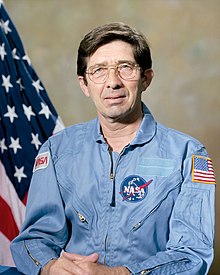Lodewijk van den Berg
| Lodewijk van den Berg | |
|---|---|
 |
|
| EG&G Payload Specialist | |
| Born |
March 24, 1932 Sluiskil, Netherlands |
|
Other occupation
|
Chemical engineer |
|
Time in space
|
7d 00h 08m |
| Missions | STS-51-B |
|
Mission insignia
|
|
Lodewijk van den Berg (Dutch pronunciation: [ˈloːdəʋɛik vɑn dɛn ˈbɛrx]; born March 24, 1932) is a Dutch American chemical engineer, specializing in crystal growth, who flew on a 1985 Space Shuttle Challenger mission as a Payload Specialist.
He was the first Dutch-born astronaut, a fact that is often ignored in the Netherlands because he was a naturalized American and no longer a Dutch citizen at the time of flight. He is married and has two children. As of 2014[update], he resides in Florida and works as a chief scientist at the Constellation Technology Corporation.
Van den Berg was born on March 24, 1932, in Sluiskil, Netherlands. Van den Berg was educated in the Netherlands where he attended the Delft University of Technology from 1949 to 1961 and earned his Engineer's degree in chemical engineering. He then moved to the United States to continue studying at the University of Delaware, where he obtained a MSc degree in applied science, followed by a PhD degree in 1974, also in applied science.
After he had completed his doctoral study, he was offered a job at EG&G Corporation Energy Measurements in Goleta, California, to work on crystal growth. EG&G was a defense contractor of the United States government and dealt with sensitive information and science. In 1975, this required Van den Berg to become a naturalized U.S. citizen. Van den Berg gathered years of research and management experience in the preparation of crystalline materials—in particular, the growth of single crystals of chemical compounds, and the investigation of associated defect chemistry and electronic properties. He became an international authority on vapor growth techniques with an emphasis on mercuric iodide crystals and its application in the nuclear industry as gamma ray detectors. During his work at EG&G, Van den Berg asked NASA for permission to conduct crystal growth experiments in space, which NASA approved.
...
Wikipedia
